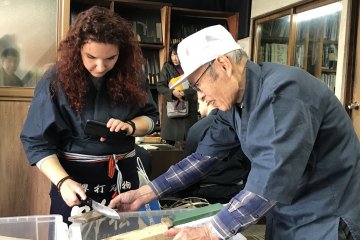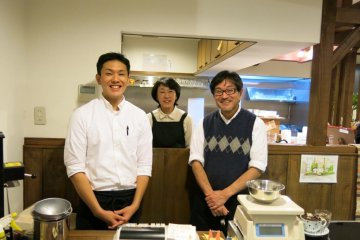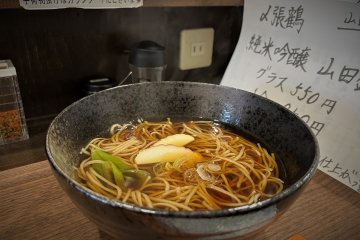There is something about the knives. Why? The soba is cut just right, not too thin, not too thick. Enough texture, enough taste, enough to absorb the stock. It was nothing like any other soba that I have tasted. Made with 100% buckwheat flour, it had a unique texture and taste. The owner cooks it in small batches, so the quality control was perfect.
So what is it about Sakai and knives? The good folk in one of Japan's oldest craft cities have been making knives for hundreds of years, and as you can see in the Sakai Knife Museum, there is a knife for every occasion, hundreds of different knives in fact, this is how specialized it is. Of course, they have a special menkiri knife just for cutting the soba noodles, and this is one of the keys to getting the perfect cut of soba noodles.
Thinking of handmade, the soba is handmade, the knives are handmade, the dashi stock is handmade, and like any proud iron chef, the menu is handwritten. So there is no English, plastic food or photo menus here, but the small family-run team here is friendly and more than happy to give you a recommendation.
While the restaurant is not large, it allows the staff to properly serve all the diners, without being stretched. Near the entrance, there is a table where a group can sit together. Then there is a counter where you can talk with the staff and watch the chefs in action. Early on Sunday, it was peaceful, quiet enough for your thoughts to take hold, though there is enough activity to make it a social experience.
Thankfully for the connoisseurs that don't live in Sakai, it is open all weekend for lunch and dinner, making it a good day trip from Osaka, and there is paid parking lot nearby. Just don't come here when it is closed on Tuesdays.
Besides cold soba with a light dipping sauce (¥850), there is duck soba as well (¥1250). The just-right sliced duck meat has a succulent pink hue and is surprisingly soft, making it a perfect pairing with the soba. If you want to take your duck culinary adventures further, try the Aigamo Duck at Naniwa Tomoare. On the other hand, their Bonito and Sudachi soup is refreshing, with the umami of the Bonito flakes being a contrast to the thinly sliced Sudachi, which is a citrus similar to Yuzu and Mandarin, but a local specialty of Tokushima, across the bay from Sakai. It is also a visual delight, having soba buried underneath the floating slices of Sudachi fruit. If that was not enough, the beautiful burgundy-colored wine salt makes a unique topping.











